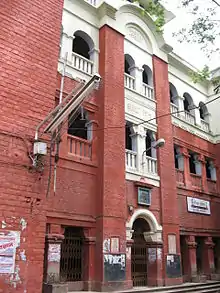
The Oriental Seminary started in 1829 by the educator Gour Mohan Addy, was the earliest privately ran, first-rate school for children of Hindu parents in Kolkata (then known as Calcutta).[1][2] It was open only to boys of Hindu parents.[3] It was possibly India’s first fully private school, as even Hindu School, Hindu College, and Hare school had to abide by certain government guidelines.[1] In earlier days, students wanting to study English had to go to the missionary schools, where they were subject to substantial religious influence. The establishment of a school for learning English, free from religious influences was a major contribution of Addy.[4] Traditional Indian education centres which taught Sanskrit and/or Persian had started fading out.
The founder and teachers
Gour Mohan Addy (20 January 1805 – 3 March 1846) founded the school without government funding. He appointed teachers to each class level by their ethnicity: Eurasian teachers for junior classes, Bengali teachers for intermediate classes, and Englishmen or Bengalis for upper levels. He died in a boating accident on the Hooghly river, when returning from a trip to Serampore to hire a teacher.[4]
Currently the principal of the primary section is Rina Basak Halder.
Notable alumni
Oriental Seminary was the earliest school Rabindranath Tagore attended.[5] The first experience of school aroused in the youngster the yearning to be a teacher. Wielding a stick, he used to teach from the railings in the big veranda of the palatial Jorasanko Thakur Bari.[6][7][8]
Among the list of other notable alumni are Bhaktisiddhanta Sarasvati,[9] Krishnadas Pal, Girish Chandra Ghosh, Womesh Chandra Bonnerjee, Sir Gooroodas Banerjee, Sambhunath Pandit, Vishwanath Datta, Amrita Lal Basu, Akshay Kumar Datta, Sudhindranath Dutta,[10] Jatindranath Sengupta, Swami Abhedananda, Bankim Ghosh, Malay Roy Choudhury and Mithun Chakraborty.[4][11][12]
References
- 1 2 Roy, Subhajoy (13 January 2006). "Pages from past lessons". Calcutta, India: The Telegraph, 13 January 2006. Archived from the original on 4 June 2011. Retrieved 4 May 2007.
- ↑ "Buddha woe over English". Calcutta, India: The Telegraph, 20 February 2005. 20 February 2005. Archived from the original on 6 March 2005. Retrieved 4 May 2007.
- ↑ Kopf, David, The Brahmo Samaj and the Shaping of the Modern Indian Mind, p. 49, Princeton University Press.
- 1 2 3 Sengupta, Subodh Chandra and Bose, Anjali (editors), 1976/1998, Sansad Bangali Charitabhidhan (Biographical dictionary) Vol I, (in Bengali), p. 147, ISBN 81-85626-65-0
- ↑ Life of Rabindranath Tagore at a glance
- ↑ Banerjee, Hiranmay, Thakurbarir Katha, (in Bengali), p. 124, Sishu Sahitya Sansad]
- ↑ Ghose, Chandreyee (7 May 2015). "Treasure trove at Tagore's school". Telegraph. India. Archived from the original on 14 July 2015. Retrieved 17 May 2018.
- ↑ "The Telegraph - Calcutta : Metro". www.telegraphindia.com. Archived from the original on 9 September 2006.
- ↑ Sardella, Ferdinando (2013a). Modern Hindu Personalism: The History, Life, and Thought of Bhaktisiddhanta Sarasvati (reprint ed.). New York, NY: Oxford University Press. p. 64. ISBN 978-0199865901.
- ↑ Sudhindranath: the Person I Knew
- ↑ Seedhi Baat -- Mithun Chakraborty
- ↑ "School wipes dust off treasure trove". www.telegraphindia.com. Archived from the original on 26 April 2014.